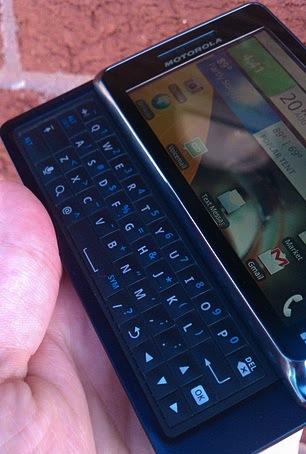
If you think about it, the DROID 2 is the one of the few high-end Android phones out there that sports a physical QWERTY keyboard. The device appeases the BlackBerry converts and physical QWERTY die-hards, and Verizon and Motorola are both well aware of it. It's also the only recent DROID unit that - knock on wood - isn't backordered. Yep, that means you should be able to walk into most Verizon stores nationwide and walk out with a shiny new device.
The DROID 2 ships in the same small, environmentally-conscious box that the DROID X and original DROID ship in. In the box, you get an AC adapter module, USB cable, 8 GB microSD card (installed in the phone), and instruction manuals. The design is largely reminiscent of the original device, save for a new bottom lip, chrome housing, and rubberized exterior buttons. The exterior is blue and silver versus the black and "brown sugar" color of the original device. I had no problem with the design of the original DROID, but I do think the design changes on the DROID 2 are improvements.
Along with the design changes, Motorola has upgraded the internals. The DROID 2 offers a 1 GHz TI OMAP processor, 8 GB of internal storage, and an 8 GB microSD card. As I've said before, 3.7-inches is my personal preference in display size, and the DROID 2 falls into that category. It offers Motorola's unconventional 854 x 480 pixel layout, making the display longer and skinnier than other devices on the market. As a result, it's easier to hold in the hand, and is more pocketable. The keyboard adds some heft to it, but even at 5.96 ounces, it's easy to put in a pocket.
The first phone to ship with Android 2.2, the DROID 2 offers the next generation of Motorola's BLUR user interface, which is what is installed on the DROID X. It's not nearly as pronounced as the Backflip and Devour days, but it's noticeable. I prefer HTC's widgets over Motorola's, but am quite fond of their "Date & Time" and "Weather" options.

After using the big devices like the EVO 4G and DROID X (which offers a larger version of the same keyboard), it took me a few minutes to get used to DROID 2's on-screen QWERTY. After some typing, I was able to use it with ease. The DROID 2's physical keyboard is a tremendous improvement over the original device. Replacing the bulky D-pad are four arrow keys, which are located within the keyboard. Individual keys are tactile and raised, and the keyboard is centered, making for an easy typing experience.
I haven't had time to give DROID 2 a thorough testing in the network department. What I will say is that in the six test calls I've made (at the time of this writing), call quality has been fantastic. I've experienced none of the signal issues that plagued early adopters; bars have been consistent and I haven't dropped any calls. Data speeds have been consistently strong - in two separate areas within the Charlotte metro area, I averaged a download speed of 1088 Kbps, and an upload speed of 836 Kbps.

FedEx delivered the DROID this morning, so I haven't worked with battery numbers. I charged it to 100 percent at 11 AM, and at 5 PM, battery life was at about 60 percent with moderate use (calling, text messaging, e-mailing, and downloading apps from the Android Market). I'm holding final judgment until official testing is complete, but I can see the DROID 2 making it through the day.
From what I can tell thus far, the DROID 2 is an excellent revision to the original, and provides an option for BlackBerry users looking to defect. The upgraded internals combined with Android 2.2 out of the box make for a great experience. The Motorola DROID 2 is available (and in stock, for the moment) for $199.99 after rebate and new two-year agreement.